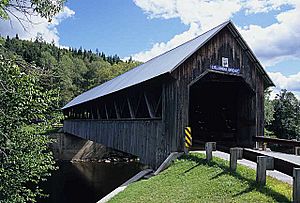Columbia Bridge (Connecticut River) facts for kids
Quick facts for kids Columbia Bridge |
|
|---|---|

Bridge in U.S. states of Vermont & New Hampshire
|
|
| Crosses | Connecticut River |
| Locale | Columbia, New Hampshire and Lemington, Vermont |
| Maintained by | Town of Columbia |
| ID number | 29-04-07 (NH #33) 45-05-02 (VT) |
| Characteristics | |
| Design | Howe truss bridge |
| Total length | 145.75 ft (44.425 m) |
| Width | 20.58 ft (6.273 m) (maximum), 14.66 ft (4.468 m) (roadway) |
| Longest span | 131.5 ft (40.08 m) |
| Load limit | 6 tons |
| Clearance above | 13.08 ft (3.987 m) |
| History | |
| Construction end | 1912 |
|
Columbia Covered Bridge
|
|
| Lua error in Module:Location_map at line 420: attempt to index field 'wikibase' (a nil value). | |
| Nearest city | Columbia, New Hampshire |
| Area | 1 acre (0.4 ha) |
| Architect | Charles Babbitt |
| Architectural style | Howe truss covered bridge |
| NRHP reference No. | 76000123 |
| Added to NRHP | December 12, 1976 |
The Columbia Bridge is a cool covered bridge that connects two states! It carries Columbia Bridge Road over the Connecticut River. This bridge links Columbia, New Hampshire and Lemington, Vermont.
It was built between 1911 and 1912. This bridge is special because it's one of only two in New Hampshire that uses a "Howe truss" design. It's also one of the very last covered bridges built during the time when many covered bridges were being constructed in both states. Because of its history, it was added to the National Register of Historic Places in 1976.
Discovering the Columbia Bridge
The Columbia Bridge is located in a quiet, rural area. It connects southeastern Lemington, Vermont, and northwestern Columbia, New Hampshire. The bridge helps people travel between U.S. Route 3 in New Hampshire and Vermont Route 102 in Vermont.
It crosses the Connecticut River in a rural, farming area. The bridge rests on strong stone supports called abutments. These supports were built using a method called "dry laid stone," which means no mortar was used. Later, they were covered with concrete for extra strength.
How the Columbia Bridge is Built
The Columbia Bridge uses a special design called a "wood-iron Howe truss." A truss is a framework of beams that supports a structure. The Howe truss uses both wood and iron parts to make the bridge very strong.
The bridge has a single span that is about 146 feet (44.5 meters) long. It's about 20.5 feet (6.2 meters) wide in total. The part where cars drive, called the roadway, is about 15.5 feet (4.7 meters) wide. There's also about 13 feet (4 meters) of space inside for vehicles to pass through.
The outside of the bridge is covered with vertical wooden boards. These boards protect the inside parts of the bridge from weather. On the north side, the siding goes up about 6 feet (1.8 meters), leaving an open space near the roof.
A Look at the Bridge's History
The Columbia Bridge was built by Charles Babbitt in 1912. It replaced an older bridge that was destroyed by fire the year before. This bridge is actually the third one to stand in this exact spot!
It's considered one of the last covered bridges built during the "historic period" of covered bridge construction in New Hampshire and Vermont. This means it's a great example of how these bridges were built a long time ago. The state of New Hampshire fixed up the bridge in 1981 to keep it safe and strong.

